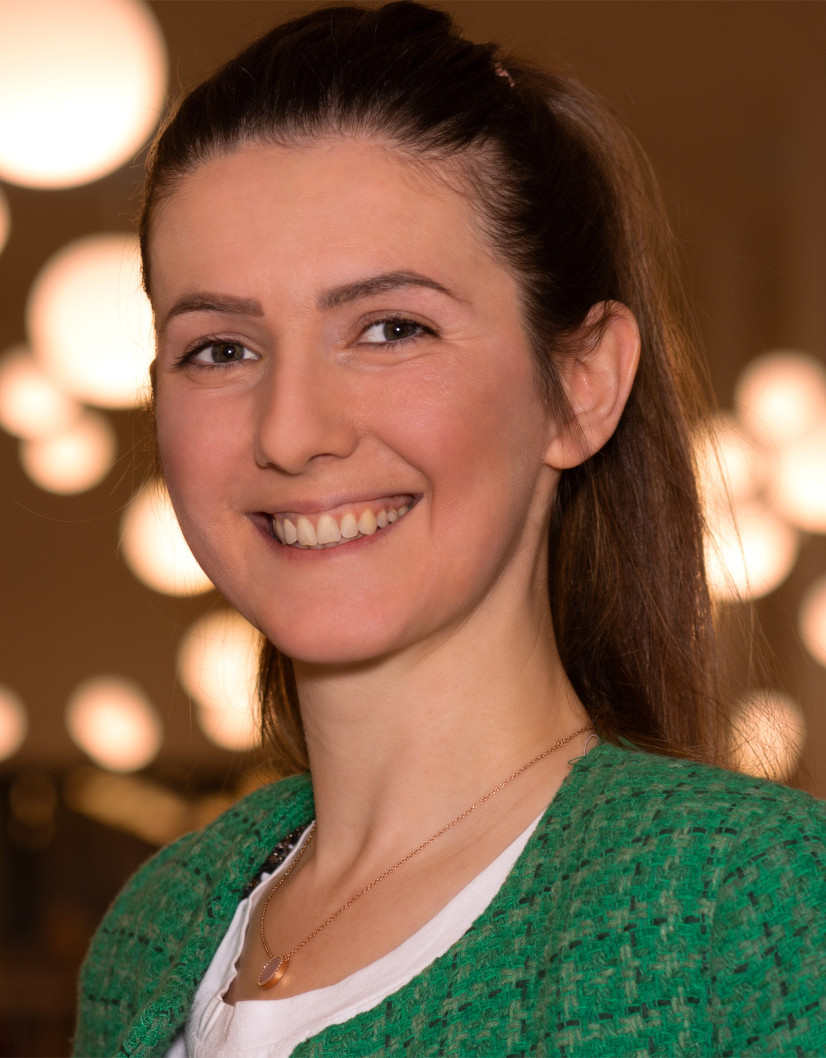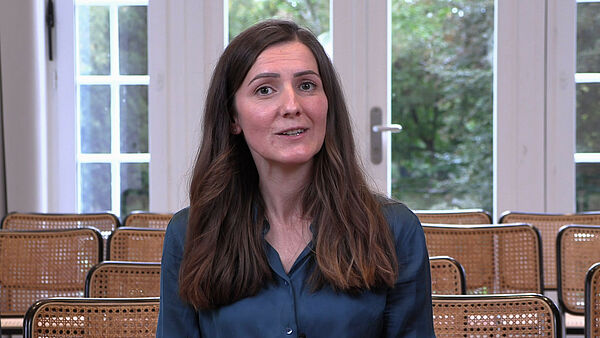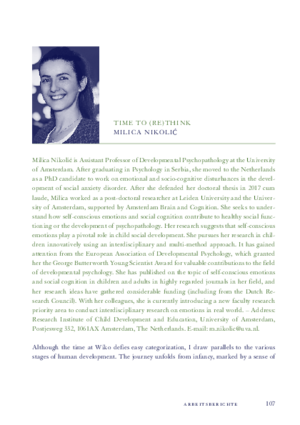
Milica Nikolic, Dr.
Psychology
Universität Amsterdam
from September 2022 to January 2023
Born in 1984 in Pirot, Serbia
Studied Psychology at the University of Novi Sad and Belgrade University and Developmental Psychopathology at the University of Amsterdam
Fellowship
College for Life Sciences
Arbeitsvorhaben
The Neural Mechanisms of Blushing
I am interested in understanding how self-conscious emotions such as shyness, embarrassment, shame, and guilt contribute to children’s social decision-making. A hallmark of self-conscious emotions is blushing – reddening of the face in response to social attention, which occurs when we think about what others think of us. My research was the first to examine blushing in children and to show that, although quickly appearing and disappearing, a child’s blushing may reflect social sensitivity and attunement to others; prolonged blushing is involved in the development of psychopathology. Blushing, thus, plays an important role in child socio-emotional development.Recently, the physiological and hormonal mechanisms and neuropharmacology of blushing have started to be unveiled. Interestingly, no neuroimaging study on blushing in humans has been done so far. Therefore, it is currently unknown how blushing and related self-conscious emotions arise on the neural system level in humans. Recently, together with colleagues, I developed a paradigm to evoke blushing in adolescents while measuring their brain activity in a MRI scanner. To do so, we first recorded participants while they were taking part in karaoke and sang difficult songs. We then played back these embarrassing videos to them while we simultaneously measured their brain activity and blushing (blood flow and skin temperature increases) in the scanner.
By comparing viewing self vs. other in an embarrassing situation, we aim to identify, for the first time, the neural correlates of blushing. We hypothesized that we will find greater activation in the brain areas involved in interoception and mentalization in relation to the occurrence and duration of blushing. Fur-thermore, we will establish which neural processes characterize prolonged vs. transient and adaptive blushing.
During my stay at Wissenschaftskolleg zu Berlin, I will spend time writing a manuscript of this study, which will form the basis for my future interdiscipli¬nary work on blushing and self-conscious emotions.
Recommended Reading
Nikolić, Milica, Lisa van der Storm, Cristina Colonnesi, Eddie Brummelman, Kees Jan Kan, and Susan Bögels (2019). “Are Socially Anxious Children Poor or Advanced Mindreaders?” Child Development 90, no. 4: 1424–1441. https://doi.org/10.1111/cdev.13248.
Nikolić, Milica, Mirjana Majdandžić, Cristina Colonnesi, Wieke de Vente, Eline Möller, and Susan Bögels (2020). “The Unique Contribution of Blushing to the Development of Social Anxiety Disorder Symptoms: Results from a Longitudinal Study.” The Journal of Child Psychology and Psychiatry 61, no. 12: 1339–1348. https://doi.org/10.1111/jcpp.13221.
Nikolić, Milica, and Tom Roth (2021). “A Comparative Glance on Self-Conscious Emotions: A Commentary on Kret et al. (2020).” Neuroscience and Biobehavioral Reviews 129: 154–156. https://doi.org/10.1016/j.neubiorev.2021.07.031.
Kolloquium, 13.12.2022
Red in the Face: Eine wissenschaftliche Betrachtung des Errötens
Mehrere soziale Emotionen, etwa Peinlichkeit, Befangenheit, Scham oder Schuldgefühle, gehen mit Erröten einher, also einer unwillkürlichen Rötung des Gesichts als Reaktion auf soziale Aufmerksamkeit. Darwin war der erste, der das Erröten systematisch beobachtete. Er kam zu dem Schluss, dass Erröten – „der menschlichste aller menschlichen Gesichtsausdrücke“ – auftritt, wenn wir darüber nachdenken, was andere von uns denken. In diesem Kontext teilt das Erröten den anderen mit, dass der Errötende seinen sozialen Normverstoß erkannt hat und dass ihm die Meinung anderer über ihn wichtig ist, wodurch er die anderen beschwichtigt und somit die negative Bewertung und Missbilligung anderer minimiert. Erröten ist universell und ein Teil des Alltags, mit dem viele von uns gut zurechtkommen. Es ist anscheinend vorteilhaft, vor anderen zu erröten, doch viele Menschen, die häufig erröten, empfinden das Erröten als höchst unangenehm und lästig; manche entwickeln sogar eine Errötungsangst. Wie kommt es, dass Erröten gleichzeitig vorteilhaft und unangenehm ist?
In diesem Vortrag möchte ich diesem Rätsel nachgehen, indem ich mich auf zwei Aspekte des Errötens konzentriere: die Perspektive der Beobachter, der Akteure und die Funktionen, die das Erröten für die jeweilige Personengruppe erfüllt. In meinem Vortrag gebe ich Ihnen einen Überblick über empirische Studien, die (1) das Erröten als soziales Signal betrachten, das die Kooperation und das Vertrauen der Beobachter erhöht, und (2) zeigen, dass das Erröten beim Akteur eher zu sozialem Vermeidungsverhalten als zu Kooperation führt. Ich erörtere die möglichen Gründe, warum Erröten für soziale Beziehungen förderlich, für den Errötenden jedoch kostspielig ist. Zum Schluss erläutere ich die physiologischen und psychologischen Prozesse, die mit dem Erröten verbunden sind. Dazu stelle ich mein aktuelles Projekt am Wissenschaftskolleg vor, in dem meine Kolleginnen, Kollegen und ich die neuronalen Grundlagen des Errötens untersucht haben.
Publikationen aus der Fellowbibliothek
Nikolic, Milica (Oxford, 2020)
Nikolic, Milica (Malden, Mass., 2019)
Are socially anxioous children poor or advanced mindreaders?

